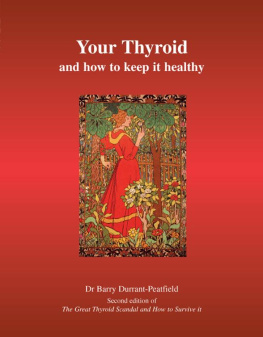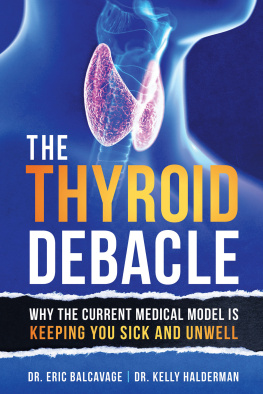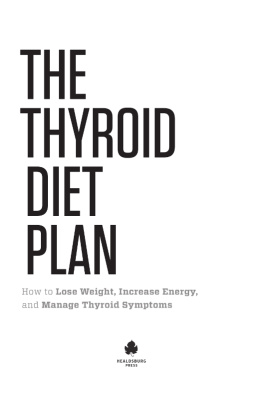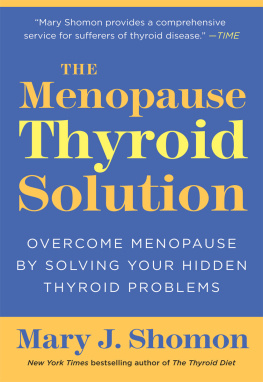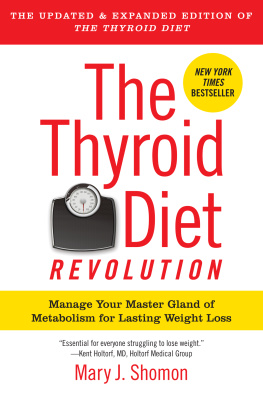I have written this book for the everyday, non-technical reader; yet many of you may well have done a fair amount of personal research into your illness so that much of what you read will be familiar. What seemed to me to be really important is that while being easy to read, you would really like to know some of the more technical aspects of thyroid disease and how they relate to other diseases. There are therefore one or two in-depth explanations which I think will not just be understood, but I hope even enjoyed; and provide you with knowledge you can put to use both in managing your treatment yourself, and enabling you to work in equal partnership with doctors or healthcare practitioners in making decisions about your illness. I have written in the manner I always use in my clinics; that is, that the patient is just as bright as I am, and perfectly able to work things out given the knowledge. To give you this knowledge, without clouding it with references within the text or blinding you with science, is I hope what I have been able to do.
The advice offered in this book, although based on my experience with many thousands of patients, is to provide information and my personal opinion. It is not intended to be a substitute for the advice and counsel of your personal physician.
In 1877 the great physician William Ord wrote a paper. He had noticed when he did his post mortems on patients whom he had failed to cure something wrong with their thyroid gland. His patients had slowly died from a condition which, beginning with general fatigue, weight gain and intractable coldness, had progressed to hair loss, bloating, extreme constipation, depression, loss of thinking powers and muscle and joint stiffness. It seemed that every system in their body slowed down and stopped; some patients slipped into coma, some into madness. But they all died, sometimes taking years and years in the process. He found that the thyroid (which as most people know sits in the neck on either side of the Adams apple) was atrophied, shrunken, scarred and fibrous. Obviously it wasnt working. Ord coined the term myxoedema as a name for the illness he was describing. The oedema (swelling) was because the skin looked bloated and puffy; the myx because although the puffiness looked like water it was actually water bound in a protein material, called mucin, which could not be drained off or treated.
Various treatments were tried. Some patients, with enlargement of the neck, got better if they were given elemental iodine. Some didnt. Eventually, Murray, in 1892, hit upon a solution: since the thyroid was atrophying or shrinking by degrees, why not grind up healthy thyroid glands from animals; all mammals have thyroid glands. By 1898 he was giving this ground-up thyroid by mouth. It may sound horrible and disgusting but two ladies, apparently terminally ill with all the symptoms we mentioned above, started getting better. Soon it was clear they were cured until the extract was stopped. He had discovered the cure for hypothyroidism. As the years passed, researchers worked out how to dry, or desiccate, the animal thyroid, so it could be put into tablet form. This desiccated thyroid is widely used today, especially in the USA; and in the UK, following its complete disuse by 1985, it is now returning.
We must turn back to 1914 when, in a masterly exposition, the great Belgian physician Eugene Hertoghe, described, as only the great physicians of the past can, the illness and how to diagnose and to treat it. It has been my great privilege to know and be taught by his grandson Jacques; and his children Thierry and Theresa Hertoghe carry on the work. He described a number of patients, men and women, in whom a bewildering variety of symptoms presented themselves; sometimes the patients were mildly ill and sometimes very ill. For a moment we can listen to his words.
When you encounter the association of one or more of the following symptoms: trophic changes [basically loss of normal health] in hair, eyebrows, eyelashes, teeth or gums; an habitual chilliness, biliary disturbances with cholelithiasis [gallstones], dyspnoea [breathlessness] with asthma attacks, menorrhagia [heavy periods], recurring abortion [miscarriage], haemophilia [bleeding and bruising tendency], melancholic depression, weariness of life, migraine, vertigo, sudden loss of consciousness, noises in the ear, somnolence, rheumatoid changes in the muscles or ligaments, loss of appetite, obstinate constipation think of possible deficiency of thyroid secretion.
We shall add other symptoms as we progress.
We owe an enormous debt to the lifes work of the great American physician Dr Broda Barnes. He began his work in the early 1930s when he studied the thyroid for his doctorate. He became a practising physician and devoted his life to bringing to the attention of doctors the true nature of hypothyroidism, and treating thousands of grateful patients. He was continually on the move, lecturing and exhibiting, and wrote many papers for medical journals. He carried on into the 1980s and founded the Barnes Foundation (Trumbull, Connecticut) to continue his work. He died in 1989 leaving behind an immense body of work and the Foundation, which is actively in existence today. It was at the Foundation that my own beliefs and anxieties about hypothyroidism found their full focus.

